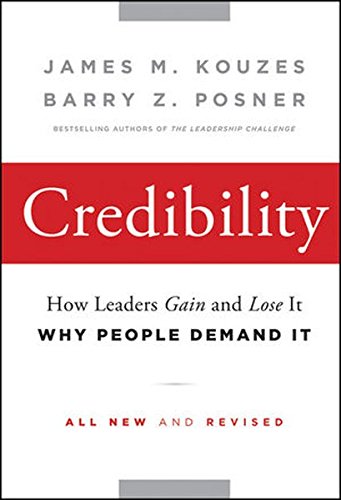BOOK FACTS
- Title: “Credibility: How Leaders Gain and Lose It, Why People Demand It”
- Author: James Kouzes & Barry Pozner
- Publisher: Jossey-Bass
- Copyright: 2003
- No. of Pages: 319
- No. of Chapters: 9
RATINGS (5 IS A MUST READ – 1 IS LOW INTEREST IN READING)
Readability: 4
Maintains Attention: 3
Applicability of Information: 4
REVIEW
In general, we found James Kouzes and Barry Posner’s book Credibility to be very applicable for today’s leader. The book begins by explaining why leadership should be thought of as a relationship. In so doing, leaders work toward identifying what others expect, and from there strive to improve the quality of their relationships. In essence, they become “credible” in the eyes of their constituents. Their credibility is then linked with improving the quality of the leadership and service they provide.
It would seem that the concept of “credibility” would be easily accomplished. After all, doesn’t everyone want to be credible? However, the complexity of life hinders this from being easily accomplished. Credibility is not just a trait to be applied to specific situations. It is a lifestyle. As Kouzes and Posner state, “credibility contributes to the hearts, bodies, minds, and souls of leaders.” A leader that is truly credible must continually strive to reflect this in his or her behavior. To accomplish this in the workplace requires leaders to eliminate the barriers between staff members and themselves. These relationships of trust and mutual respect are paramount in ensuring organizational success. Leaders who lead with “credibility” foster not just their own success, but promote traits in others that help them succeed as well. (It should be noted that success in this context goes beyond monetary rewards. According to Kouzes and Posner, “success is leaving the area a better place than when you found it.”)
In chapter two, instructions are given to the reader to reflect on the various qualities of effective leadership that they have experienced. The reader is also introduced to six disciplines of credibility: discover yourself, appreciate constituent, affirm shared values, develop capacity, serve a purpose, and sustain hope. From these disciplines, chapters three through eight serve as a guide for readers to discover and explore these traits from a personal perspective, as well as relate them to those they serve.
The final chapter acknowledges the fact that struggles are imminent when trying to achieve credibility. Caution must be given when balancing the freedoms and constraints of constituents. Considerations must also be given for conflicting leadership styles. Kouzes and Pozner identify some of these considerations and close by offering suggestions for setting goals to achieve a new beginning in leadership.
It should be noted that throughout the book, Kouzes and Pozner substantiate the information of Credibility with data obtained from various case studies.
SUMMARY OF MAIN POINTS
According to Kouzes and Pozner, leaders must first explore the six disciplines of credibility: discover yourself, appreciate constituents, affirm shared values, develop capacity, serve a purpose, and sustain hope. Leaders must also realize that credibility is a lifestyle, not just a trait applied to specific situations. According to Kouzes and Pozner, “leaders must get smart about people” in order to succeed.
As a result of reading Credibility, Kouzes and Pozner believe that leaders will learn:
- The qualities that constituents look for and admire in leaders
- The foundation of leadership and of all working relationships
- The actions you can take to apply the practices to your own leadership initiatives
- The struggles leaders face in living up to their constituents’ expectations
- The principles and disciplines that strengthen leadership credibility
CALL TO ACTION
After reading this book, the following five strategies are a must do for leaders interested in
developing “Credibility”:
- Allow and encourage employees to give feedback and make this action the norm..
- Create an environment that encourages and promotes teaching.
- Show concern for your employee’s personal welfare. Ask appropriate questions and respond to stated needs.
- Be visible and available.
- Be honest, trustworthy, and credible. Once credibility is negatively altered, the unity and intensity needed to strengthen credibility are also lost.


